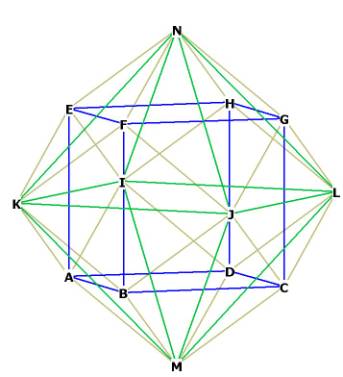|
(2019
midterm assignment) Model Midterm answers 2019 (Index) Essay 1: Compare, contrast, and evaluate Narratives of the Future |
 |
Eileen Burnett
March 27, 2019
Breaking It Down: The Narratives
That Move Us
Stories are an essential part of the
human experience, a part of human nature. Stories captivate us, take us to other
worlds, and provide a reprieve from what is often the drudgery of everyday life.
Rich and powerful, stories catch our
attention and force us to look forward, encouraging and revealing answers to the
most basic of humanity’s questions, such as: Where are we going? And what does
our future hold? Within this class, three types of narrative models unfold,
creation apocalypse, evolutionary, and alternative, each revealing to us the
frameworks that build such stories of renowned, ranging from scriptural texts
like The Bible to H.G. Wells’ The Time
Machine. Each of these three categories, in turn, is made up of unique
characteristics that deal with some important questions of epistemology, time
and its relativity, and humanity in vastly different ways.
Structures like creation/apocalypse deal with the
implication that though humanity’s situation was once good, due to outside
influence these things have changed and now require a remedy. evolution, and
alternative narrative forms. We are
drawn to apocalyptic literature for the same reasons we gravitate towards
narratives of adventure in video games- to be a part of something bigger,
something ancient, and something over which it is possible to prevail, breaking
us out of the mundaneness of reality and catapulting us into the fantastical. In
the Biblical narrative, specifically the first book of The Bible, the Book of
Genesis, humanity is portrayed as having been in a utopian state at
its inception, but as a result of this outside influence (Satan in the form of
the serpent, “more subtil than any beast of the field” (Gen 3:1)) mankind is now
relegated to hardship and frustration. The last book of the Bible, the
Book of Revelation is the apocalypse
part of the narrative, flip side where restoration comes through a great
cataclysm. At the behest of God the Father, the angels in the throne room begin
to play trumpets, pour bowls and vials, and proclaim “woes” to the inhabitants
of the earth, revealing to humanity “the fierceness of his wrath” (Rev 16:19),
and thus cleansing the earth and restoring it to perfection.
But this is not the only story that falls under this
narrative style. Clark Omo comments on Octavia Butler’s
Parable of the Sower, citing its
similarity to “the story of Genesis from the Bible, along with its Apocalyptic
counterpart, Revelation” for reference. Within
Parable, Butler weaves a similar
framework, where an economic crash leads to a dystopic future. Lauren, the main
character of the story, embarks on a quest to return to and Eden-like lifestyle
through her cult of Earthseed, whose cryptic scripture dealing with God as
change overlay the structure of the book. “It focuses attention, strengthens
purpose, and unifies people” (214) Lauren writes. This desire to return to the
way things once were is a classic example of how
Parable illustrates the
creation/apocalyptic narrative. Both stories occur within a reasonable and
easily acceptable linear timeline, espousing more traditional, if not also
conservatively religious- values, using similar symbols for commonly held ideas,
such as gardens, the theme of redemption, and the overwhelming pressure of
decline.
Literature of the future can also fall within more than
one category. According to Timothy
Morrow, Octavia Butler’s Parable of the Sower,
H.G. Wells’ The Time Machine, and
the short story “Stone Lives” fall into this dual category, encompassing
not only the traditional apocalypse/creation narrative, but also delving into
the evolution style, which values scientific knowledge and its pursuit over any
other form of acquisition. Pragmatical and calculating in its approach, the
evolutionary category is also distinctively different from the
apocalypse/creation narrative in that the timeline is often set in terms of a
cyclical cosmic scale, often taking into account events that occur over a period
of millions of years. Parable is a great example of this blending of the
apocalyptic and evolutionary narratives, as it takes the reader from a present
cataclysm to a time to hundreds, maybe thousands of years into the future
through Lauren’s idea for her new religion, Earthseed. Her plan is for it to
spread across the solar system, even galaxies, in an interconnected network of
an evolved humanity.
Evolution also works
within species, as in the case of “Bears Discover Fire” by Terry Bisson. In this
story, bears evolve beyond the lumbering, forest-dwelling creatures of old to a
species that learns how to use fire. To the main character, his mother, and his
son, Wallace, Jr., these bears have formed a human-like society, full of family
structures and community, just like us. “The big bear” Bisson writes, “tended
the fire, breaking up the dry branches by holding one end and stepping on them,
like people do.” This parallel of bears and humans draws on the intellectual
concept of Darwinism, an essential component of the evolutionary model. Social
Darwinism is often the mode of human interaction, and Bears plays into
this standard flawlessly, making it both an interesting and appealing read.
The final category
for future narratives is the alternative future, of which H.G. Wells’ The
Time Machine is a prime example. Alternative timelines work because they
operate on the premise that the actual act of creating the ideal is in fact the
ideal itself; that is, when placed in a situation where actual perfection is
reached, this attainment gives most people a disconcerting feeling, akin to a
loss of hope. People want to know that there is something more to hope for.
Wells utilizes this fact when he merges the evolutionary with the alternative
narratives, specifically in his descriptions of the species inhabiting the
earth. Wells paints the picture of a Marxist segregation of communities that
lead, 800,000 years in the future, to the formation of the Eloi, the former
upper class of humanity who, due to excessive leisure and lack of stimulus, have
evolved into a childlike, simple-minded sort of creature, unfazed by need or
suffering, and the Morlocks, the lower, worker class of citizens who devolved
into a subterranean, animalistic form which preyed upon the sheep-like Eloi for
sustenance.
In
like manner, “The Garden of Forking Paths” by Jorge Luis Borges imparts
alternative realities through the labyrinthian layout of the book within the
story as infinite universes in itself. “An invisible labyrinth of time” (40)
Borges calls it, one in which an infinite amount of possibilities unfold before
you, creating layer after layer of potential truths from which any number of
reflections and permutations can occur. Borges capitalizes on the complexity of
the mind, the ever changing and branching myriad of choices that lay before us
as humans, condensing the ideas to a single book. Alternative timelines do not
operate in the typical linear fashion as the previous two models, and is
therefore much more convoluted and mystical in nature.
Stories can fall into one or several of these categories, adding richness and flavor to the narratives that are unique to this category. Stories like Genesis and Revelation from scripture exemplify the creation/ apocalypse narrative in that they give hope for a better future through a trial by fire. Tales of evolution such as Parable of the Sower and Bears Discover Fire tell stories of growth, showing us what we one day might become. And alternative Narratives like The Time Machine and Garden of Forking Paths lead us into strange and new places, warning us of the consequences of even the smallest of actions. Within these three categories, therefore, are captivating stories that answer profound questions of where we are going as a humanity, bringing a sense of peace, that at least these stories are not in our visible future, and that we still have time to make something of it.
 |
 |
 |
